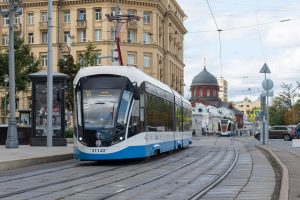 Moscow authorities intend to replace the exiting tram fleet with low-floor trams by 2023. Currently there are 800 trams in the Russian capital and 50% are low-floor three-section Vityaz-Moskva trams.
Moscow authorities intend to replace the exiting tram fleet with low-floor trams by 2023. Currently there are 800 trams in the Russian capital and 50% are low-floor three-section Vityaz-Moskva trams.
The city is focused on a complete renewal strategy of its rolling stock. In the last ten years, 70% of the fleet has been replaced and in the next three years, only low-floor trams will operate on all Moscow routes.
In 2021, a fleet of 109 new generation of trams will enter commercial services. There will be 19 three-section trams and 109 single-section cars.
“Moscow is a modern megalopolis with a multimillion population. Our task is to make sure that every day every citizen has the opportunity to travel to work, the city center or any other part of Moscow quickly and comfortably using surface transport. The tram is the most reliable overground mode of transport, it is reliable and eco-friendly, so we do everything to preserve and develop the tram network in Moscow, while aligning with the best foreign practices”, said Leonid Antonov, the General Director of Mosgortrans, the public transport operator of Moscow.
The Moscow tram is one of the key modes of transport for the city. It ranks second after the metro transport in terms of carrying capacity. In 2019, the tram network carried 212 million passengers, which is 12 times more than the population of Moscow.
In addition to purchasing modern cars, Moscow develops its transport infrastructure. To make tram traffic regular and reduce the number of emergency situations, Moscow will create dedicated tram lines. currently, the vehicles cannot travel on 80% of tram lines. In these areas, the number of accidents decreased by 60%. All trams arrive at stops once in a certain period, for example, every 8 minutes. When trams arrive at stops at the same minutes of every hour, it is easier for passengers to navigate the schedule and to plan their trip.
The tram tracks are replaced and repaired. Since 2010, more than 250 km have already been repaired, representing more than a half of the total tram network in the city. After the reconstruction, the noise level is reduced by 30% and vibration-insulating mats are installed. The tram stops are also modernised and repaired. Today there are already 270 modernised stops which are located at the level of 30 centimeters above the tracks to be on the same level with the entrance to the tram for the comfort of the passengers with disabilities.
Share on:



